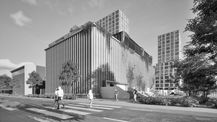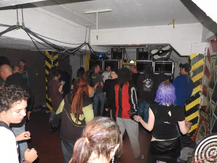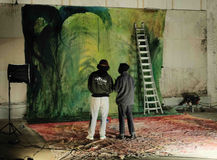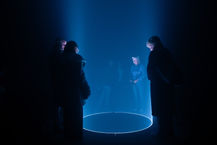History
Now a heritage monument and a hub for artistic and tech communities, Koelhuis has a rich history tied to Eindhoven’s dairy industry, ice cream production, and underground cultures. Discover the vibrant story of the Koelhuis building below.
Early 1900s
A story of milk and growth
While the Dutch have always loved milk and cheese, it wasn’t until the early 20th century that the country saw an explosive industrialization of the sector. The first modern dairy factory in Eindhoven was established in 1917, under the name “Melkinrichting St Joseph”.

1961
The Campina factory complex
With the industrialization of Eindhoven, starting in the late 50s, farmhouses in this area were gradually replaced by industrial buildings. In 1961, a large factory complex merged many small, local establishments under the newly coined name Campina – from the Latin name of the region, nowadays known as De Kempen. During the 60s, the soaring demand for ice cream and the development of pioneering refrigerating technologies lead to new and more efficient production and distribution practices. To make the most of the factory plant, Campina needed a massive freezer.

1969
A polar bunker filled with ice cream
Campina hired architect H.G.A. Reef to design the freezer warehouse now standing before you as a remarkable example of pragmatism. With about 20000 m3 storing capacity available across the street, the dairy factory could now increase its production. High volumes of ice cream were stored at -30° C behind the characteristic walls of the building. State-of-the-art freezer trucks would then distribute Campina ice cream across the country and abroad. Fun fact: the vertical pattern of the façade is created by an alternative use of ‘double-T plates’, flat building blocks normally used horizontally to form platforms and pavements.

1980s
The heyday is over
During the 1980s, many changes happened in the dairy industry, and Campina responded by restructuring and relocating its plants from the area. Now redundant, the freezer warehouse was gradually dismissed after an honorable career of about 20 years. It was first used as a regular non-refrigerated storage, and eventually left vacant, until it was noticed by squatter communities.

2000s
Underground days
In the new millennium, the building, now more and more referred to as ‘Koelhuis’, became a reference point for members of the local underground counterculture. Where ice cream was once tidily stocked at polar temperatures, now party animals gathered for nightlife events, raves and graffiti art. During these years of intense use, the building got more and more rundown. While it was a cool hotspot for some locals, for others, Koelhuis became a symbol of decadence and shady business.

2017 - 2021
Preserving Industrial Heritage
Koelhuis was ultimately scheduled to be demolished. Eindhoven was about to lose a distinctive landmark, an industrial monument symbolizing the economic heritage of the city. Luckily, the unique profile of this mysterious concrete box inspired Tom Bakkers, an Eindhoven-based real estate entrepreneur, to acquire the building and save it from demolition. Bakkers was not the only one who saw the potential of this concrete giant. In 2020, creative entrepreneurs Gianni Jorissen and Patrick de Koning hosted temporary placemaking initiatives in the building, which was also chosen as a location for films, photoshoots and art experiments.

2021 – present
Becoming IX Hub
In 2021, Concrete Culture started developing and implementing the vision of transforming Koelhuis into a large–scale hub for immersive experiences (IX). Koelhuis became activated with exhibitions and artistic projects, hosting events and becoming an official opening location for Dutch Design Week 2024.
At the same time, this industrial heritage building gave rise to the plans for the Koelhuis District around it. The area where Koelhuis stands now is set for a significant transformation, with the Canal Zone as a central point, creating a new gateway to the city. Koelhuis District Eindhoven will play a crucial role as a cultural catalyst in these developments. This cultural district is an ambitious
urban renewal project focused on Immersive Experiences, media art, and contemporary culture, leveraging talent in the innovative Brainport region and building on Eindhoven’s reputation as the design and tech capital of the Netherlands.
Koelhuis, as a cultural and tech hub at the heart of the district, will focus on new media art, immersive technology, and contemporary culture, aiming to make complex themes more accessible to the public through (digital) immersive experiences. The district will offer permanent and affordable living and working spaces for creative and technical talent, becoming a permanent incubator, retaining
talent in the city.

























